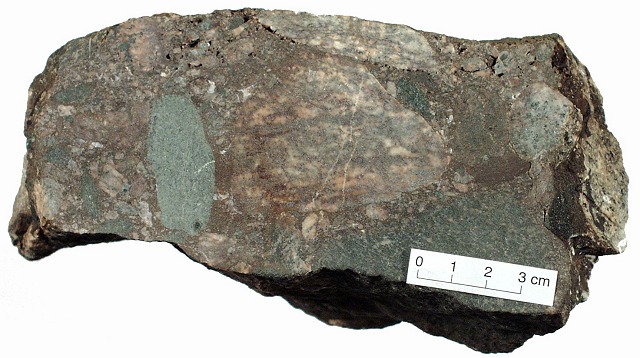
| Home | Geological History | Stratigraphy | Area map | Rock Index | About |
| Scourie | Achmelvich | Laxford | Clachtoll | Stoer | Assynt | Skiag Bridge | Glencoul | Knockan | Borralan | Ledmore |
This rock type immediately overlies the Lewisian Gneiss at Clachtoll, NW of Lochinver

![]() Basal
conglomerate, Stoer Group (Torridonian), Clachtoll
Basal
conglomerate, Stoer Group (Torridonian), Clachtoll
This rock type fills valleys in an irregular surface eroded into Lewisian gneiss about 1200 million years ago. It consists of angular blocks of gneiss up to 30 cm across, with a coarse sandy matrix. There is very little trace of bedding; elsewhere on this outcrop there were a few thin gritty layers, arranged parallel to the hammer shaft. The rock is very poorly sorted, i.e. the gneiss fragments show a full range of sizes from 30 cm down to sand grain size. They are also very poorly rounded, implying the material has not travelled far from its source. Indeed they are so angular that many geologists would call this rock a breccia, rather than a conglomerate.

![]() Basal
conglomerate, Stoer Group (Torridonian), Clachtoll
Basal
conglomerate, Stoer Group (Torridonian), Clachtoll
This photograph of the cut face of a hand specimen shows the Lewisian gneiss clasts (broken and transported fragments). They are slightly rounded, and of a great range of size. The sandy matrix of the rock is dark purplish brown, and the brown staining has affected parts of the light-coloured gneiss clasts. All the rock types represented in the clasts can be found in the underlying gneiss nearby, and are unlikely to have travelled far from thier source. There are felsic gneisses (e.g. large clast at centre), mafic gneiss (under the scale bar), and ultramafic gneiss (upright clast, left of centre). This material would have accumulated at the foot of the valley slopes, to be swept along and re-deposited by occasional floods.
This rock is too coarse grained for a thin section view to be appropriate
| Scourie | Achmelvich | Laxford | Clachtoll | Stoer | Assynt | Skiag Bridge | Glencoul | Knockan | Borralan | Ledmore |
| Home | Geological History | Stratigraphy | Area map | Rock Index | About |
D.J. Waters, Department of Earth Sciences, May 2003